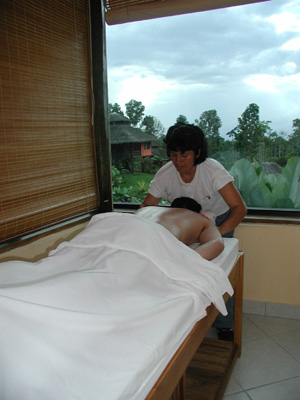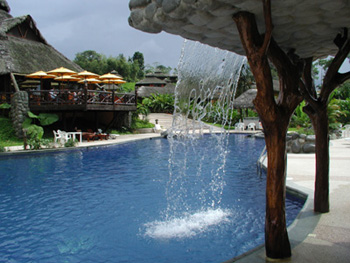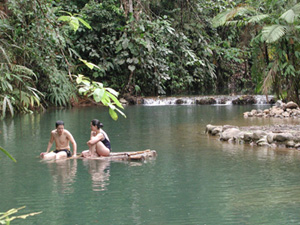|
 Spending
hours glued to a hard-bottomed canoe to spot one jungle bird
isn't for everyone, but I thought that taking my middle-aged
parents on a tour of the Ecuadorian Amazon would reawaken
their sense of adventure. Spending
hours glued to a hard-bottomed canoe to spot one jungle bird
isn't for everyone, but I thought that taking my middle-aged
parents on a tour of the Ecuadorian Amazon would reawaken
their sense of adventure.
As we zoomed deeper into the jungle along
the Río Coca in an outboard-motor-powered canoe, rain and
bugs smacking us in the face, my mother -- a petite, high
school home economics teacher -- said, "Well, I guess I better
forget about fixing my hair here."
I finally realized that maybe Mom wasn't
going to dig picking leeches off her rubber boots. But the
next time she ventures to my adopted homeland, I'll know where
to take her. Now there is a spot in Ecuador's tropical forests
where tourists can not only fix their hair, but also have
their feet rubbed, get a facial and relax with an aromatherapy
treatment - no malaria tablets needed.
The Arashá Rain Forest Resort and Spa
may start opening up Ecuador's tropical areas to a new niche
of tourists. It's located not in the dark heart of the Amazon,
but in the cooler tropical forests just two hours by car from
the capital city of Quito.
FROM BACKPACKS TO BACKRUBS
Tourism in this small Andean country
has long been a bastion of backpackers proud to boast of their
exploits in the rough. Travel-on-a-shoestring Lonely Planet
guidebooks abound in battered backpacks while the more elegant
Fodor's books are found in the handbags of tourists passing
through the Quito airport to head to more expensive yacht
tours in the Galápagos Islands.
Some tour operators are starting to look
for ways to encourage affluent tourists to spend more time
and money on the mainland. Arashá's owners saw a niche for
tourists without the three to four days necessary to go to
the Amazonian lodges or the desire for such a challenge.
Amazon jungle tours don't require tourists
to be Survivor-contestant caliber at all - some are even fairly
luxurious and provide gourmet food and hot water - but all
require at least a few hours in a canoe, some desire to slosh
through muddy trails and a strong mosquito repellant.
While Arashá marketing manager Jorge
Cabezas admits that few people will come to Ecuador just to
go to the spa, its location fits in well with tours to see
other spots of interest in the country, such as the Indian
markets in Otavalo or the coast. Arashá offers travelers a
chance to see some of the country's tropical forests without
a long trip or special gear. And while neither the flora nor
fauna is as dense and exotic as in the Amazon, the palm-tree
surrounded spa can help make up for that to all but the most
die-hard naturalist traveler.
 JOINING
THE TRIBE JOINING
THE TRIBE
Which I thought I was. While not as extreme
of some of my friends, in college I liked to think of myself
as somewhat of a shoestring traveler, staying in low-budget
hostels and eating whatever the locals did. I tried not to
associate much with the Fodor's crowd, and I never thought
about fixing my hair in the jungle. But since I've permanently
moved to Ecuador, I noticed myself starting longingly at the
Arashá sign every time we passed it on the road to stay in
some dive on the beach.
My husband and I finally decided to splurge
and stay at Arashá, "just to check it out for when my parents
come to visit," I rationalized. I didn't tell any of my biologist
friends - who consider anything more than a carp and a roll
of recycled biodegradable toilet paper unnecessary luxuries
and environmentally damaging - that I was going.
We drove up to the resort on a parking
lot paved with the dried shells of African date palms, a local
agricultural product. While waiting for a van to carry us
and our luggage from the parking lot to the resort (so as
to have less cars in the main area), my husband and I followed
the "Mirador" sign down a short path to get an overview of
the resort, which spreads across a small valley. That first
impression is that of having found a lost tribe of interior
decorators - 26 rustic yet elegant thatched-roof cabañas in
sherbet shades blend with the vegetation and nestle naturally
into the hillsides.
My feeble defenses were coming down fast
- I caught myself wondering if there were hairdryers in the
rooms.
No hairdryers, as it turned out, but
there is electricity. The cabañas are split diagonally into
two guest rooms with either two single beds or one double,
decorated with distressed ceramic tile floors, carved Ecuadorian
wooden furniture and decorations, bamboo architectural accents
and painted ceilings with exposed wooden beams. Large windows
and front porches let the laziest nature watchers observe
hummingbirds and other small creatures from their rooms.
There are no radios, television or air
conditioning - screened openings in the top of the cabañas
let hot air escape while a ceiling fans provides all the needed
ventilation. The average daily temperature is only 78 degrees.
Each room does come equipped with a phone, but they are all
cellular lines so expect to pay accordingly, especially for
international calls.
 Instead
of heading first to the spa, we decided to ease more gradually
into this life of leisure. We took a short walk down a self-guided
path to where the resort has partially dammed a short length
of the Río Negrito to form a small swimming area. Floating
in the dark water, surrounded by dripping vegetation flowing
down the ravine walls, it was hard to believe that we were
just about two hours from the mountainous, chilly and polluted
confines of Quito. Instead
of heading first to the spa, we decided to ease more gradually
into this life of leisure. We took a short walk down a self-guided
path to where the resort has partially dammed a short length
of the Río Negrito to form a small swimming area. Floating
in the dark water, surrounded by dripping vegetation flowing
down the ravine walls, it was hard to believe that we were
just about two hours from the mountainous, chilly and polluted
confines of Quito.
We decided to dry off during lunch, and
joined several other Ecuadorian couples and families at the
yellow-umbrella covered tables on a deck overlooking the pool.
We noticed that most of the guests were Ecuadorians, not foreigners,
a trend that we confirmed with some of the resort employees.
Ecuadorians are quite family oriented, so expect to see children
at all meals, in the pool and on expeditions. Especially on
Sundays, some upper-class families - grandparents and nannies
included -- drive from Quito just for the afternoon buffet.
The food prices are exorbitant by Ecuadorian
standards, but inexpensive when compared with domestic spas.
The menu - which offers mainly traditional Ecuadorian dishes
with a gourmet twist - runs from $3 to $7 for most plates.
Our meals for two always seemed to run between $15 and $20.
Their head chef has had training in Switzerland, and the meals
are worth the price.
Sated and starting to enjoy this guilty
pleasure, we headed to the spa - a baby blue building on top
of a hill. My husband had initially protested the idea of
a facial, muttering something about real men not putting lotion
on their face, but finally relented. I signed him up for the
Padre Perfecto - Perfect Father - a $24 one-hour treatment
that includes hydrotherapy (translation: a trip to the Jacuzzi),
a back massage and men's facial. I opted for the two-hour
Toque del Cielo - Touch of Heaven - for $35, which included
again the Jacuzzi dip, full-body massage, facial and aromatherapy
treatment (translation: being wrapped in scented, hot, wet
towels). The spa offers basic but enjoyable services, with
facials starting at $12.
ULTIMATE SACRIFICE
As I reposed on fresh white linens and
let someone massage my back and shoulders with sandalwood-scented
oil, I tried to focus on how this process was helping the
tropical environment, sustainable community-based industries,
the ozone layer and humanity in general. Despite my self-indulgent
exaggeration, tourism industries such as this do help preserve
what is left of virgin forests in this area. Unlike the Amazon,
which receives a lot of press, these tropical forests have
been virtually ignored until recently. Much of it has been
destroyed by agriculture, which is also how most people in
this region --- overwhelmingly poor both in numbers and degree
- scrape out a living.
The 120-acres that Arashá occupies were
saved only because of their unsuitability for farming - hills
and valleys make planting difficult. The area that the cabañas
take up is the only part that was previously cultivated in
recent times. It's not a legitimate "eco-lodge" - there are
no composting toilets or attempts to conserve much water or
paper -- but it certainly has a lot less impact than a high-rise
luxury hotel.
The owners of Arashá - ironically former
and current petroleum executives -- are also working with
a Quito-based non-profit foundation to buys some surrounding
wilderness to both serve as a fauna buffer zone for the resort
and to preserve the forest, said Arashá's Mr. Cabezas.
"The attraction of Arashá is nature,"
Mr. Cabezas said. "We have to preserve as much as possible."
Several other smaller lodges and tourism
enterprises in this area are either slated to open soon or
have just started up, creating the possibility for more local
employment in the industry. Many of the headwaiters and managers
at Arashá are actually from Quito, not the surrounding areas
where there aren't many opportunities to learn good customer
service techniques. But many of the helpers and apprentices
do come from nearby towns and villages, so the resort is hoping
to start developing its own local workers, Mr. Cabezas said.
KARAOKE FROGS
But our guide on a three-hour outing
to a local river, the Río Caoní, was probably from the southern
part of the Ecuador, judging from his accent. Henry Cárdenas
pointed out different plants during the hike, such as the
one with roots that glow in the dark at night. He was much
more helpful and knowledgeable guides on other tours I have
taken. He even swabbed alcohol from a first-aid kit on whelps
that sprang up on my arm after I clumsily brushed against
a toxic plant.
The resort also offers some tours that
cost from $2 to $5 extra. A five-hour trip to a nearby lagoon
include the park admission cost and a another tour takes guests
through the entire process of making chocolate, from harvesting
the locally-grown yellow cocoa fruits to eating a chocolate
fondue.
After taking these tours, exhausted from
so much relaxation, we expected to fall asleep to the sounds
of frogs croaking. Instead, a moody Spanish love ballad sung
in a croaky voice wafted through the air. It turns out that
Arashá has its own small convention center, complete with
a 129-person theater and karaoke machine, which seems to be
a popular activity at Ecuadorian conventions. If you don't
want to fall asleep to interpretations of the complete works
of Ecuadorian crooner Julio Jaramillo, I suggest requesting
a cabin far away from the convention center, at least on weekend
nights.
But despite the late-night karaoke, I
awoke the next morning convinced that staying on the beaten
path once in a while in my travels might not hurt me. Arashá
doesn't show the same type of ecological awareness as some
of the greenest jungle lodges, but it also might provide introduce
a new type of tourist and tourism dollars to the country.
And maybe my mother had a good idea -
fixing my hair in the jungle was kind of nice.
If You Go
Arashá costs $55 a night plus 22 percent tax
for double occupancy from Sunday to Thursday, and $68 plus
tax Fridays and Saturdays. Contact the hotel at info@arasharesort.com
or see more details at www.arasharesort.com.
The Quito office is located at Av. De Los Shyris 3941 and
Río Coca, Building Monte Carlo, 8th Floor. Call 593-2-265-757
or fax 593-2-260-992. The resort telephone is 593-9-820-183
and the telefax number is 593-9-8200-174. The rainy season
runs from January to April or May.
To reach Arashá from Quito, buses from
the Kennedy, Aloha and San Pedrito lines leave from the main
bus station in Quito every hour from 6 a.m. to 5:30 p.m. A
one-way ticket for the approximately two-and-half-hour trip
costs about $2.50. The bus does not automatically stop at
Arashá, located at kilometer 120, so inform the driver when
you board. If you don't speak Spanish, find a friendly-looking
bilingual tourist to do it for you. Keep your own eyes peeled
for the resort's large sign to the left, because drivers sometimes
forget to stop.
Taking a taxi from Quito is also an option,
if you can find a cabby with four or five hours to spare.
The one-way trip should cost between $25 and $35 - although
some bargaining will be required. Establishing a fare ahead
of time will be cheaper than using the taximeter.
If you have nerves of steel, arriving
in a rental car is a risky possibility. Make sure to get an
International Driving Permit from AAA before leaving home
and watch out for the crater-like potholes, people walking
in the road, cocoa and coffee beans drying on the edges of
the highway and cows. (I was once stalled on this road for
more than two hours by a parade of slow-marching school children.)
|